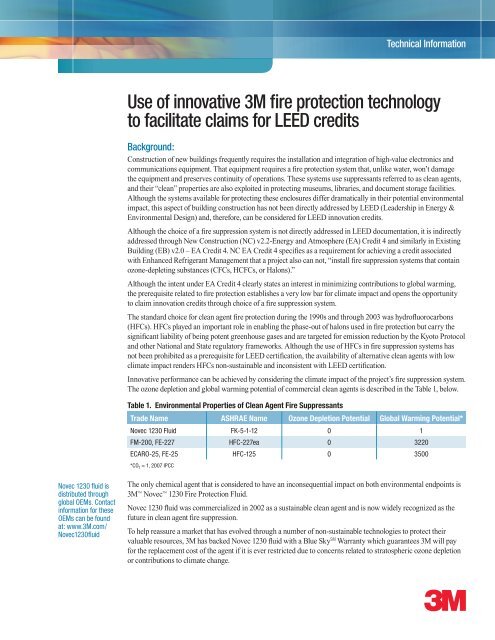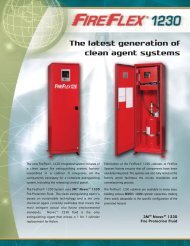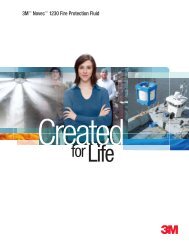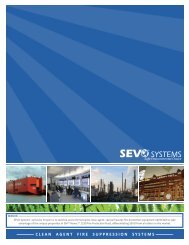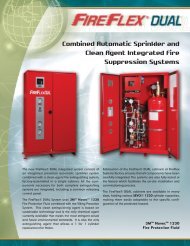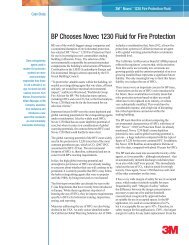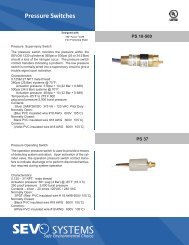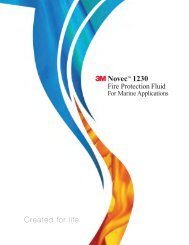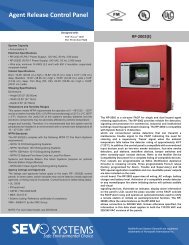Use of innovative 3M fire protection technology to facilitate claims for ...
Use of innovative 3M fire protection technology to facilitate claims for ...
Use of innovative 3M fire protection technology to facilitate claims for ...
Create successful ePaper yourself
Turn your PDF publications into a flip-book with our unique Google optimized e-Paper software.
Novec 1230 fluid is<br />
distributed through<br />
global OEMs. Contact<br />
in<strong>for</strong>mation <strong>for</strong> these<br />
OEMs can be found<br />
at: www.<strong>3M</strong>.com/<br />
Novec1230fluid<br />
Background:<br />
Construction <strong>of</strong> new buildings frequently requires the installation and integration <strong>of</strong> high-value electronics and<br />
communications equipment. That equipment requires a <strong>fire</strong> <strong>protection</strong> system that, unlike water, won’t damage<br />
the equipment and preserves continuity <strong>of</strong> operations. These systems use suppressants referred <strong>to</strong> as clean agents,<br />
and their “clean” properties are also exploited in protecting museums, libraries, and document s<strong>to</strong>rage facilities.<br />
Although the systems available <strong>for</strong> protecting these enclosures differ dramatically in their potential environmental<br />
impact, this aspect <strong>of</strong> building construction has not been directly addressed by LEED (Leadership in Energy &<br />
Environmental Design) and, there<strong>for</strong>e, can be considered <strong>for</strong> LEED innovation credits.<br />
Although the choice <strong>of</strong> a <strong>fire</strong> suppression system is not directly addressed in LEED documentation, it is indirectly<br />
addressed through New Construction (NC) v2.2-Energy and Atmosphere (EA) Credit 4 and similarly in Existing<br />
Building (EB) v2.0 – EA Credit 4. NC EA Credit 4 specifies as a requirement <strong>for</strong> achieving a credit associated<br />
with Enhanced Refrigerant Management that a project also can not, “install <strong>fire</strong> suppression systems that contain<br />
ozone-depleting substances (CFCs, HCFCs, or Halons).”<br />
Although the intent under EA Credit 4 clearly states an interest in minimizing contributions <strong>to</strong> global warming,<br />
the prerequisite related <strong>to</strong> <strong>fire</strong> <strong>protection</strong> establishes a very low bar <strong>for</strong> climate impact and opens the opportunity<br />
<strong>to</strong> claim innovation credits through choice <strong>of</strong> a <strong>fire</strong> suppression system.<br />
The standard choice <strong>for</strong> clean agent <strong>fire</strong> <strong>protection</strong> during the 1990s and through 2003 was hydr<strong>of</strong>luorocarbons<br />
(HFCs). HFCs played an important role in enabling the phase-out <strong>of</strong> halons used in <strong>fire</strong> <strong>protection</strong> but carry the<br />
significant liability <strong>of</strong> being potent greenhouse gases and are targeted <strong>for</strong> emission reduction by the Kyo<strong>to</strong> Pro<strong>to</strong>col<br />
and other National and State regula<strong>to</strong>ry frameworks. Although the use <strong>of</strong> HFCs in <strong>fire</strong> suppression systems has<br />
not been prohibited as a prerequisite <strong>for</strong> LEED certification, the availability <strong>of</strong> alternative clean agents with low<br />
climate impact renders HFCs non-sustainable and inconsistent with LEED certification.<br />
Innovative per<strong>for</strong>mance can be achieved by considering the climate impact <strong>of</strong> the project’s <strong>fire</strong> suppression system.<br />
The ozone depletion and global warming potential <strong>of</strong> commercial clean agents is described in the Table 1, below.<br />
Table 1. Environmental Properties <strong>of</strong> Clean Agent Fire Suppressants<br />
Trade Name ASHRAE Name Ozone Depletion Potential Global Warming Potential*<br />
Novec 1230 Fluid FK-5-1-12 0 1<br />
FM-200, FE-227 HFC-227ea 0 3220<br />
ECARO-25, FE-25 HFC-125 0 3500<br />
*CO 2 = 1, 2007 IPCC<br />
Technical In<strong>for</strong>mation<br />
<strong>Use</strong> <strong>of</strong> <strong>innovative</strong> <strong>3M</strong> <strong>fire</strong> <strong>protection</strong> <strong>technology</strong><br />
<strong>to</strong> <strong>facilitate</strong> <strong>claims</strong> <strong>for</strong> LEED credits<br />
The only chemical agent that is considered <strong>to</strong> have an inconsequential impact on both environmental endpoints is<br />
<strong>3M</strong> Novec 1230 Fire Protection Fluid.<br />
Novec 1230 fluid was commercialized in 2002 as a sustainable clean agent and is now widely recognized as the<br />
future in clean agent <strong>fire</strong> suppression.<br />
To help reassure a market that has evolved through a number <strong>of</strong> non-sustainable technologies <strong>to</strong> protect their<br />
valuable resources, <strong>3M</strong> has backed Novec 1230 fluid with a Blue SkySM Warranty which guarantees <strong>3M</strong> will pay<br />
<strong>for</strong> the replacement cost <strong>of</strong> the agent if it is ever restricted due <strong>to</strong> concerns related <strong>to</strong> stra<strong>to</strong>spheric ozone depletion<br />
or contributions <strong>to</strong> climate change.<br />
3
The <strong>3M</strong> Novec <br />
Brand Family<br />
Product <strong>Use</strong>: All statements, technical in<strong>for</strong>mation and recommendations contained in this document are based on tests or experience that <strong>3M</strong> believes are reliable. However, many<br />
fac<strong>to</strong>rs beyond <strong>3M</strong>’s control can affect the use and per<strong>for</strong>mance <strong>of</strong> a <strong>3M</strong> product in a particular application, including conditions under which the product is used and the time and<br />
environmental conditions in which the product is expected <strong>to</strong> per<strong>for</strong>m. Since these fac<strong>to</strong>rs are uniquely within the user’s knowledge and control, it is essential that the user evaluate the<br />
<strong>3M</strong> product <strong>to</strong> determine whether it is fit <strong>for</strong> a particular purpose and suitable <strong>for</strong> the user’s method <strong>of</strong> application.<br />
Warranty and Limited Remedy: Unless stated otherwise in <strong>3M</strong>’s product literature, packaging inserts or product packaging <strong>for</strong> individual products, <strong>3M</strong> warrants that each <strong>3M</strong> product<br />
meets the applicable specifications at the time <strong>3M</strong> ships the product. Individual products may have additional or different warranties as stated on product literature, package inserts or<br />
product packages. <strong>3M</strong> MAKES NO OTHER WARRANTIES, EXPRESS OR IMPLIED, INCLUDING BUT NOT LIMITED TO, ANY IMPLIED WARRANTIES OF MERCHANTABILITY OR FITNESS<br />
FOR A PARTICULAR PURPOSE OR ANY IMPLIED WARRANTY ARISING OUT OF A COURSE OF DEALING, CUSTOM OR USAGE OF TRADE. <strong>Use</strong>r is responsible <strong>for</strong> determining whether the<br />
<strong>3M</strong> product is fit <strong>for</strong> a particular purpose and suitable <strong>for</strong> user’s application. If the <strong>3M</strong> product is defective within the warranty period, your exclusive remedy and <strong>3M</strong>’s and seller’s sole<br />
obligation will be, at <strong>3M</strong>’s option, <strong>to</strong> replace the product or refund the purchase price.<br />
Limitation Of Liability: Except where prohibited by law, <strong>3M</strong> and seller will not be liable <strong>for</strong> any loss or damage arising from the <strong>3M</strong> product, whether direct, indirect, special, incidental,<br />
or consequential regardless <strong>of</strong> the legal theory asserted, including warranty, contract, negligence or strict liability.<br />
3<br />
Electronics Markets<br />
Materials Division<br />
<strong>3M</strong> Center, Building 224-3N-11<br />
St. Paul, MN 55144-1000<br />
www.<strong>3M</strong>.com/novec1230fluid<br />
1-800-251-8634<br />
The Novec brand is the hallmark <strong>for</strong> a variety <strong>of</strong> patented <strong>3M</strong> compounds. Although each has its own unique <strong>for</strong>mula and per<strong>for</strong>mance properties, all<br />
Novec products are designed in common <strong>to</strong> address the need <strong>for</strong> safe, effective, sustainable solutions in industry-specific applications. These include<br />
precision and electronics cleaning, heat transfer, <strong>fire</strong> <strong>protection</strong>, lubricant deposition and several specialty chemical applications.<br />
<strong>3M</strong> Novec Engineered Fluids ■ <strong>3M</strong> Novec Aerosol Cleaners ■ <strong>3M</strong> Novec 1230 Fire Protection Fluid ■ <strong>3M</strong> Novec Electronic Coatings ■ <strong>3M</strong> Novec Electronic Surfactants<br />
United States<br />
<strong>3M</strong> Electronics Markets<br />
Materials Division<br />
800 810 8513<br />
Documentation:<br />
To assist you in completing your LEED project documentation, please consider the following responses under,<br />
“Innovation and Design Process”<br />
Intent: Consider the climate impact <strong>of</strong> the “clean agent” <strong>fire</strong> suppression system incorporated in<strong>to</strong> the project.<br />
Although EA Credit 4 precludes use <strong>of</strong> an ozone depleting substances in a <strong>fire</strong> suppression system, climate impact<br />
is not specifically addressed in LEED certification. The impact <strong>of</strong> the various agents and systems that could be<br />
installed varies dramatically.<br />
Requirement: Do not install <strong>fire</strong> suppression systems that contain ozone-depleting substances (CFCs,<br />
HCFCs, or Halons) or compounds with high global warming potential such as hydr<strong>of</strong>luorocarbons (HFCs) and<br />
perfluorocarbons (PFCs). HFCs and PFCs are excluded because the GWP <strong>of</strong> those agents is greater than 3000 and<br />
7000 times that <strong>of</strong> CO2, respectively. In addition, there is no indirect benefit <strong>of</strong> energy efficiency when an HFC is<br />
used in a <strong>fire</strong> <strong>protection</strong> system.<br />
Submittals:<br />
1. A peer reviewed summary <strong>of</strong> the agents used in <strong>fire</strong> suppression can be found in the <strong>fire</strong> <strong>protection</strong> chapter <strong>of</strong> the<br />
Intergovernmental Panel on Climate Change, “Special Report on Safeguarding the Ozone Layer and the Global<br />
Climate System.” The report can be found at, http://www.ipcc.ch/pdf/special-reports/sroc/sroc_full.pdf<br />
2. The atmospheric properties <strong>of</strong> Novec 1230 fluid are described in: Taniguchi, N., Walling<strong>to</strong>n, T.J., Hurley, M.D.,<br />
Guschin, A.G., Molina, L.T., Molina, M.J., Journal <strong>of</strong> Physical Chemistry A, 107(15), 2674-2679, 2003.<br />
3. The U.S. EPA list <strong>of</strong> approved agents can be found at: http://www.epa.gov/ozone/snap/lists/index.html. In<br />
their approval <strong>of</strong> Novec 1230 fluid, the U.S. EPA noted that, a.) “EPA has reviewed the potential environmental<br />
impacts <strong>of</strong> this substitute and has concluded that, by comparison <strong>to</strong> halon 1301 and other acceptable<br />
substitutes, (FK-5-1-12) significantly reduces overall risk <strong>to</strong> the environment.” and, b.) “(FK-5-1-12) provides an<br />
improvement over use <strong>of</strong> halon 1301, hydrochlor<strong>of</strong>luorocarbons (HCFCs) and hydr<strong>of</strong>luorocarbons (HFCs) in <strong>fire</strong><br />
<strong>protection</strong>. We find that C 6-perfluoroke<strong>to</strong>ne is acceptable because it reduces overall risk <strong>to</strong> public health and the<br />
environment in the end use listed.”<br />
China<br />
<strong>3M</strong> China Ltd.<br />
86 21 6275 3535<br />
–U.S. EPA 12/20/02 Federal Register<br />
Design Approach:<br />
This project will use a will use a <strong>fire</strong> suppression system that incorporates <strong>3M</strong> Novec 1230 Fire Protection Fluid.<br />
Europe<br />
<strong>3M</strong> Belgium N.V.<br />
32 3 250 7521<br />
Japan<br />
Sumi<strong>to</strong>mo <strong>3M</strong> Limited<br />
813 3709 8250<br />
Please recycle. Printed in USA.<br />
Issued: 10/08 © <strong>3M</strong> 2008.<br />
All rights reserved. 6526HB<br />
60-5002-0355-3<br />
Korea<br />
<strong>3M</strong> Korea Limited<br />
82 2 3771 4114<br />
Singapore<br />
<strong>3M</strong> Singapore Pte. Ltd.<br />
65 454 8611<br />
Taiwan<br />
<strong>3M</strong> Taiwan Limited<br />
886 2 2704 9011<br />
ECARO-25 is a trademark <strong>of</strong> Fike Corporation.<br />
FM-200 is a registered trademark <strong>of</strong> E.I. du Pont<br />
de Nemours and Company and its affiliates.<br />
<strong>3M</strong> and Novec are trademarks <strong>of</strong> <strong>3M</strong>.<br />
<strong>Use</strong>d under license by <strong>3M</strong> subsidiaries and affiliates.


